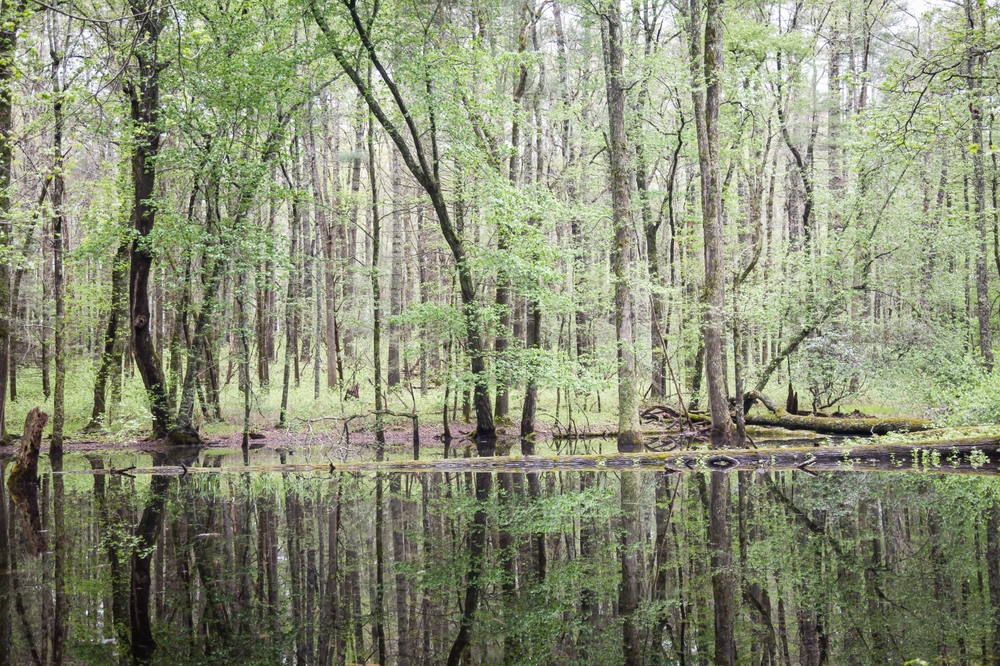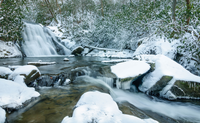The timeless natural beauty of the Great Smoky Mountains National Park is home to many diverse ecosystems, even wetlands! A wetland is defined as a low-lying area of land that is covered with water, either seasonally or year-round. This moist habitat is vital for water quality, reducing stream erosion, and flood protection; it also provides a home for many creatures and plants, such as salamanders. So far, park scientists have mapped over 600 wetlands in the area, from marshes and swamps to sinkholes and beaver ponds! Read on to learn more about a few places where you’ll find wetlands in the Smokies:
Gum Swamp in Cades Cove

Named for the abundance of black gum trees in the area, Gum Swamp is a wetland area in Cades Cove near the Visitor Center. The trees contribute to the natural beauty of the land year-round with white flowers in the spring and bright red leaves in the fall. Another interesting thing about Gum Swamp is that scientists have analyzed charcoal concentration trends here to aid in wildfire suppression efforts. They are doing everything they can to keep the land beautiful for years to come. As for animals, there are lots of frogs that call this swamp home! You will hear their low croak before you see them!
Fighting Creek Nature Trail
The Fighting Creek Nature Trail is located behind the Sugarlands Visitor Center. The loop is just over a mile long and flat, which means it is great for kids and people who can’t walk far! Keep an eye out for wetlands along the way. You’ll find them in treeless areas with tall sedge grass and wildflowers. As for other highlights on this trail, you’ll find the John Ownby cabin. It was built in 1860 using rocks and clay mortar along with dovetail notching! It was restored in 1964, and the front porch was replaced.
The Ice Water Springs Shelter Along The Appalachian Trail

Another place to see wetlands in the Smokies is along the trail to Mount Kephart and the Ice Water Spring Shelter. The wetlands here have many sedge species, a type of tall and wispy grass that is ideal for small animals to hide in. You may also see some tall wildflowers. As for the Ice Water Springs Shelter, this is a popular backcountry campsite! Since this route is part of the much longer Appalachian Trail, the shelter is typically used by AT thru-hikers or backpacking trips. The roof keeps campers dry from the rain, and it’s an awesome place to see sunrises and sunsets.
Ways to Protect Wetlands in the Smokies
You might be wondering, why are wetlands so important, and why should you care? These areas are far from useless and contribute to the national park’s biodiversity! So when you’re out exploring in the Smoky Mountains, keep the Leave No Trace policy in mind. This means:
- Avoid walking directly through a wetland. The goal is to minimize any disturbance to these areas to protect the species living there.
- Clean up any litter. This goes beyond not littering– if you see a piece of trash, pick it up and dispose of it yourself in one of the bear-safe trash cans throughout the park.
- Leave everything as you found it. This includes not picking wildflowers, throwing rocks, picking up small creatures, etc.
Now you know more about wetlands in the Smokies! Curious about other unique features of the national park’s ecosystem? How about an unusual plant species? Read about the ghost plant in the Smoky Mountains and where to find it!








